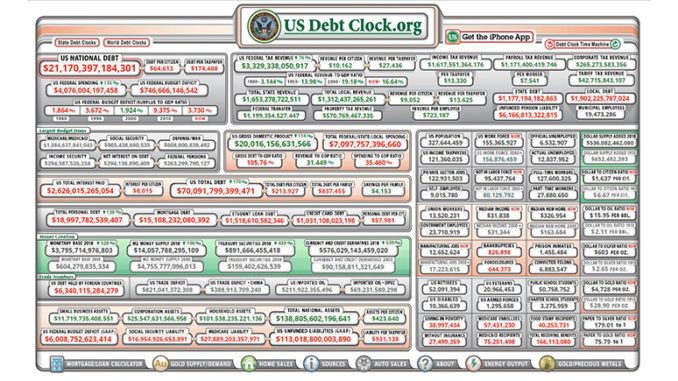
“I’m the king of debt. I love debt.” That was then Republican Presidential candidate Donald Trump during a May 2016 interview with CNN’s Wolf Blitzer.
Donald Trump would go on to win the Presidency. During fiscal year 2017, the nation’s budget deficit rose nearly 14% to $665.8 billion. However, most of the revenue and spending decisions had been made prior to President Trump’s taking office. Therefore, one could not pin that increase in the country’s budget deficit on the Trump Administration. Instead, another fiscal year’s data was needed. That data is now coming in.
During the first six months of the current fiscal year, which began on October 1, 2017, the nation had a cumulative budget deficit of $599.7 billion. That is 13.8% above the $526.9 billion registered during the same period of the previous fiscal year. Further, much more red ink lies ahead.
In its latest Monthly Treasury Statement, the Department of Treasury estimated that the full-year deficit will increase 25% from the preceding fiscal year to $832.6 billion. That is even higher than the recently published Congressional Budget Office (CBO) estimate $804 billion.
Even worse, on the nation’s current fiscal course, trillion dollar deficits lurk in the near future. In its 2018-2028 budget outlook, the CBO explained:
Under the assumption that current laws governing taxes and spending generally remain in place, the amount by which the government’s outlays exceed its revenues would nearly double in nominal terms over the next several years, rising from $665 billion in 2017 to $1.3 trillion in 2022. The budget deficit would increase more slowly thereafter–to a total of $1.5 trillion in 2028.
A number of factors could result in changes to this forecast. Such possible developments include:
- The trend and volatility of economic growth, both for structural and/or cyclical reasons.
- Changes in real interest rates.
- The renewal of some or all of the 2017 tax law’s provisions that are set to expire within 10 years. Already, there is a move afoot in the House of Representatives to do just that.
- The impact of an unexpected and significant geopolitical shock or natural disaster.
- Realization of contingent liabilities e.g., as had been the case when the federal government injected capital into Fannie Mae and Freddie Mac during the 2008 financial crisis.
- Relative changes in global capital market attractiveness and funding needs.
In the longer-term, structural imbalances associated with the nation’s entitlement programs will need to be addressed. The longer reforms are delayed, the more wrenching the adjustment could be. Toward that end, the 2017 OASDI Trustees Report explained:
If substantial actions are deferred for several years, the changes necessary to maintain Social Security solvency would be concentrated on fewer years and fewer generations. Much larger changes would be necessary if action is deferred until the combined trust fund reserves become depleted in 2034.
The 2017 Medicare Trustees Report provided a similar narrative, warning:
The financial projections in this report indicate a need for substantial steps to address Medicare’s remaining financial challenges. Consideration of further reforms should occur in the near future. The sooner solutions are enacted, the more flexible and gradual they can be.
Following its 2017 Article IV consultation with the United States, the IMF advised:
Over a longer horizon, if the fiscal costs associated with an aging demographic remain unaddressed, the debt-GDP ratio will continue to rise which may call into question the creditworthiness of the federal government. However, with the economy so close to full employment any fiscal impulse at this juncture is unadvisable and will almost certainly lead to a steepening of an already-unsustainable federal debt-GDP path… Instead, a gradual fiscal consolidation should be pursued.
The IMF added that U.S. debt dynamics are particularly vulnerable to changes in economic growth and real interest rates. Even modest reductions in the rate of long-term economic growth and/or modest increases in real interest rates could have a large impact on the growth of the nation’s nominal debt burden and its debt burden relative to GDP.
The warnings about the nation’s growing fiscal deficits are both clear and plentiful. If those warnings are ignored out of political expediency or the prevailing “deficits don’t matter” consensus in Congress and the Senate, future historians may borrow from Charles Dickens to describe the 2020s as an “age of foolishness” in the United States. Much worse, that era could be followed by a “season of darkness,” if not a “winter of despair.”
Long live the King of Debt? To date, that’s the clear message that has risen above the partisan tumult of an otherwise severely divided Congress.
